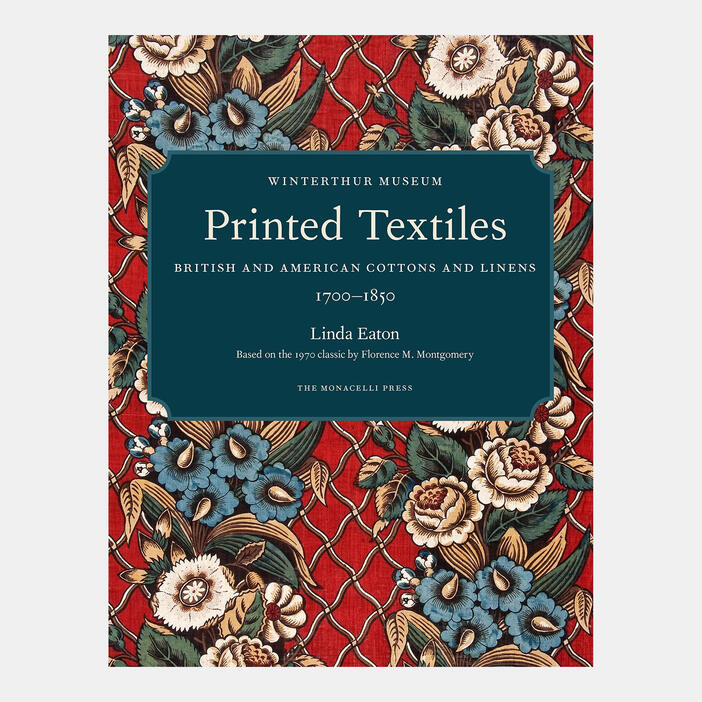

Printed Textiles: British and American Cottons and Linens 1700-1850
Price AUD$130.00 Price CAD$97.00 Price €74.95 Price USD$85.00 Price T85.00
The Winterthur Museum’s richly illustrated history of British and American fabrics made or used from 1700–1850 is a visual reference for designers and a definitive contribution to textile studies.
From slipcovers that belonged to George Washington, to bedhangings described by Harriet Beecher Stowe, Delaware’s Winterthur Museum holds some of the finest cotton and linen textiles made or used in America and Britain between 1700 and 1850. One of the fastest growing and potentially most lucrative trades in the eighteenth and early nineteenth centuries, on the forefront of developments in science and engineering, chemistry and technology, the textile industry is a fascinating lens into international trade relations and cultural exchange over nearly two centuries. Printed Textiles is a major update to the classic text published by Winterthur in 1970 - a sourcebook compiled by celebrated curator Florence Montgomery that detailed all aspects of the fabrics’ lifespan, from their design and method of manufacture to their use and exchange value. Linda Eaton, Director of Collections and Senior Curator of Textiles, updates the classic with a particular focus on furnishing fabrics - referred to as “furnitures.” Building on research that has come to light since 1970 and benefiting from the technical and scientific expertise of the conservators and scientists at Winterthur, Eaton presents a thorough and sweeping study enriched by the diverse approaches to material culture today. With hundreds of beautifully photographed samples - engagingly contextualized with iconic figures in American history including Betsy Ross and Benjamin Franklin - this significant addition to textile scholarship allows for a full appreciation of these fascinating fabrics. Printed Textiles is destined to become an essential reference for interior designers, fashion and textile design students, conservators, collectors, and anyone with an interest in the textile industry.
Specifications:- Format: Hardback
- Size: 287 × 212 mm (1119/64 × 811/32 in)
- Pages: 384 pp
- Illustrations: 600 illustrations
- ISBN: 9781580933933
Linda Eaton is the John L. & Marjorie P. McGraw Director of Collections and Senior Curator of Textiles at Winterthur. She is the author of Quilts in a Material World, among many publications.
‘Florence Montgomery’s 1970 book on textiles - those made or used in America or Britain between 1700 and 1850 - is revered on both sides of the pond. Forty-five years later, Eaton has fully revised and updated Montgomery’s work in this beautiful volume. Textiles scholars, historians, collectors, and designers will find Eaton and Montgomery’s work impeccable and inspiring. Destined to follow in the footsteps of its predecessor, this new volume will no doubt become a classic work on material culture.’ - Library Journal
‘The book’s six chapters thoroughly cover the salient topics in this field, from 'British Trade with North America' and 'The Use of Printed Furnitures in America [i.e. furnishing fabrics, from upholstery to curtains and bed hangings]' to a study contextualizing the professional experience of innumerable fabric designers whose names went unrecorded. The catalogue following these chapters is a visual delight, depicting in detail almost four hundred examples from the Winterthur collection. A splendid addition to the field of material culture.’ - The Magazine 'Antiques'
‘Part of the value of this remarkable book is its being ‘based on the 1970 classic by Florence M. Montgomery,’ but Linda Eaton’s additional scholarship is invaluable. The photography is revamped to reveal the nuances of the textiles and related materials. This textile tale wraps itself around the daily lives of some historical people known for other things. . . . I was struck by the numerous references to and quotes from Benjamin Franklin. Eaton gives us many thousands of details and examples in her six chapters of perspective, and leads the way to a deeper appreciation. Enjoy this great reference book—superlative on many levels. The catalog of printed textiles that follows the chapters could become in itself and inspiration to designers, costumers, and historians of many stripes. What a treasure we have in the Winterthur collection.’ - Maine Antique Digest
‘One of those dreamy resources where everything you need for a good handle on the subject is provided but which leaves room for, and inspires, further research. While Montgomery's 1970 edition was groundbreaking and is now a classic, the subject matter deserves this beautiful updated version. More of our beloved academic texts should be given this kind of respectful revitalization.’ - Selvedge (UK)
‘Over 600 beautiful color photographs enhance the publication and put a wealth of detail and information at the fingertips of anyone fascinated by textile studies. The first half of Printed Textiles provides an in-depth exploration of the British and American textile printing industries, the use of these fabrics in furnishings, the designers and their designs, and notably, the chemistry of calico printing. The second half of the book provides a catalogue offering a rich visual banquet of motifs and colors. These motifs are stunningly intricate and widely varied, and display a continuum from multiple colors to monochrome. Flora and fauna in books and paintings were a rich source for textile designers, who employed artistic license to create elaborate patterns that could work well in a printed repeat. Similarly, scenes from historical, mythological, theatrical, and literary sources were popular. Even caricatures found their way onto fabrics. Linda Eaton’s achievement here is to take an already seminal work and bring it a step further, expanding on the scholarship and providing new visuals to create a richly nuanced history of an industry at the leading edge of the industrial revolution. It belongs in the hands of designers, collectors, and textile aficionados alike.’ - AATCC (Association of Textile, Apparel & Materials Professionals) Review